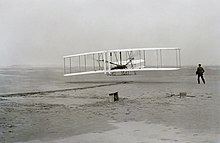Early beginnings
There are early legends of human flight such as the stories of Icarus in Greek myth, Jamshid and Shah Kay Kāvus in Persian myth,[3] and the flying automaton of Archytas of Tarentum (428–347 BC).[4] Later, somewhat more credible claims of short-distance human flights appear, such as the winged flights of Abbas ibn Firnas (810–887, recorded in the 17th century), Eilmer of Malmesbury (11th century, recorded in the 12th century), and the hot-air Passarola of Bartholomeu Lourenço de Gusmão (1685–1724).
Lighter than air

LZ 129 Hindenburg at Lakehurst Naval Air Station, 1936
The modern age of aviation began with the first untethered human lighter-than-air flight on November 21, 1783, of a hot air balloon designed by the Montgolfier brothers.[5] The usefulness of balloons was limited because they could only travel downwind. It was immediately recognized that a steerable, or dirigible, balloon was required. Jean-Pierre Blanchard flew the first human-powered dirigible in 1784 and crossed the English Channel in one in 1785.
Rigid airships became the first aircraft to transport passengers and cargo over great distances. The best known aircraft of this type were manufactured by the German Zeppelin company.
The most successful Zeppelin was the Graf Zeppelin. It flew over one million miles, including an around-the-world flight in August 1929. However, the dominance of the Zeppelins over the airplanes of that period, which had a range of only a few hundred miles, was diminishing as airplane design advanced. The “Golden Age” of the airships ended on May 6, 1937, when the Hindenburg caught fire, killing 36 people. The cause of the Hindenburg accident was initially blamed on the use of hydrogen instead of helium as the lift gas. An internal investigation by the manufacturer revealed that the coating used in the material covering the frame was highly flammable and allowed static electricity to build up in the airship.[6] Changes to the coating formulation reduced the risk of further Hindenburg type accidents. Although there have been periodic initiatives to revive their use, airships have seen only niche application since that time.[7]
Heavier than air
In 1799, Sir George Cayley set forth the concept of the modern airplane as a fixed-wing flying machine with separate systems for lift, propulsion, and control.[8][9]
Otto Lilienthal was the first person to make well-documented, repeated, successful flights with gliders,[10] therefore making the idea of “heavier than air” a reality. Newspapers and magazines published photographs of Lilienthal gliding, favourably influencing public and scientific opinion about the possibility of flying machines becoming practical. Lilienthal’s work led to him developing the concept of the modern wing.[11][12] His flight attempts in 1891 are seen as the beginning of human flight[13] and the “Lilienthal Normalsegelapparat” is considered to be the first airplane in series production, making the Maschinenfabrik Otto Lilienthal the first air plane production company in the world.[14] Lilienthal is often referred to as either the “father of aviation”[15][16][17] or “father of flight”.[18]
Early dirigible developments included machine-powered propulsion (Henri Giffard, 1852), rigid frames (David Schwarz, 1896) and improved speed and maneuverability (Alberto Santos-Dumont, 1901)

First powered and controlled flight by the Wright brothers, December 17, 1903
There are many competing claims for the earliest powered, heavier-than-air flight. The first recorded powered flight was carried out by Clément Ader on October 9, 1890, in his bat-winged, fully self-propelled fixed-wing aircraft, the Ader Éole. It was reportedly the first manned, powered, heavier-than-air flight of a significant distance (50 m (160 ft)) but insignificant altitude from level ground.[19][20][21] Seven years later, on 14 October 1897, Ader’s Avion III was tested without success in front of two officials from the French War ministry. The report on the trials was not publicized until 1910, as they had been a military secret. In November 1906, Ader claimed to have made a successful flight on 14 October 1897, achieving an “uninterrupted flight” of around 300 metres (980 feet). Although widely believed at the time, these claims were later discredited.[22][23]
The Wright brothers made the first successful powered, controlled and sustained airplane flight on December 17, 1903, a feat made possible by their invention of three-axis control. Only a decade later, at the start of World War I, heavier-than-air powered aircraft had become practical for reconnaissance, artillery spotting, and even attacks against ground positions.
Aircraft began to transport people and cargo as designs grew larger and more reliable. The Wright brothers took aloft the first passenger, Charles Furnas, one of their mechanics, on May 14, 1908.[24][25]

Leave a Reply